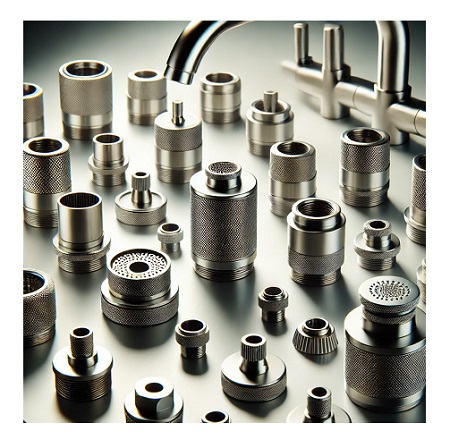
Faucets in high-traffic areas must operate continuously, meet cleanliness standards, and be highly durable. Airports accommodate thousands of travelers every day, hospitals require stringent infection-control measures, and colleges host large numbers of students who frequently use restrooms. Understanding key faucet components—such as cartridges, O-rings, aerators, and common failure points—helps reduce downtime, improve water efficiency, and enhance user safety.
This article clearly explains each internal component, how it functions, why it fails, and what facility managers can do to extend system lifespan and reduce maintenance costs.
Cartridges: The Core of the Faucet
A faucet’s cartridge is essentially the heart of the water control mechanism. It regulates water flow, mixing, and shutoff accuracy.

Types of Cartridges
- Ceramic Disc Cartridges – Most common today; extremely durable and reliable.
- Compression Cartridges – Older style, more prone to leaks; still found in older buildings.
- Thermostatic Cartridges – Maintain stable temperature, essential in hospitals and some airports.
How a Cartridge Works
The cartridge controls how hot and cold water mix as the handle is moved. In touchless faucets, a solenoid triggers flow, but the cartridge still regulates pressure and temperature.
Common Cartridge Failure Points
- Wear of ceramic surfaces → Causes dripping even in OFF position.
- Mineral buildup → Leads to stiff handle movement or inconsistent flow.
- Erosion from high-pressure systems → Seen in airports and older campus buildings.
- Faulty thermostatic element → Dangerous for hospitals because incorrect temperature increases scalding risk.
Why This Matters in High-Traffic Facilities
- Hospitals: Temperature accuracy is critical for patient safety. A faulty cartridge can violate safety protocols.
- Airports: Cartridges undergo heavy cycles per day—durability is essential.
- Colleges: Students often misuse handles; robust cartridges minimize costly repairs.
O-Rings: Small Components with Big Impact
O-rings are rubber seals preventing leaks at the handle, spout base, and connection joints. They are inexpensive yet crucial.

How O-Rings Function
When water pressure changes, O-rings expand and contract to maintain a watertight seal. They also support smooth handle rotation.
Common O-Ring Failures
- Hardening and cracking due to age or heat.
- Chemical degradation — especially in hospitals using harsh disinfectants.
- Incorrect lubrication — low-quality grease damages rubber.
- Water chlorination — accelerates drying and cracking.
- Wrong-size replacements — a common issue in college maintenance teams.
Symptoms of Failing O-Rings
- Leaks around the base of the spout
- Side drips during handle movement
- Mold or moisture buildup on counters
- Reduced handle mobility
Why This Matters
- Hospitals: Liquid intrusion encourages bacteria growth; sealing integrity is essential.
- Airports: Large restrooms multiply water loss costs if dozens of faucets drip.
- Colleges: Leaking faucets raise water bills for campus facilities already operating on tight budgets.
Aerators: The Hidden Tool for Efficiency and Hygiene
The aerator is the mesh assembly at the faucet’s tip. It mixes air with water to reduce flow while maintaining pressure.

Functions of Aerators
- Control flow rate
- Reduce water waste
- Improve user comfort by reducing splash
- Filter out small debris
- Maintain laminar or aerated flow
Types of Aerators
- Standard Aerators – Used in public restrooms with 1.5 GPM flow.
- Laminar Flow Devices – Essential for hospitals to reduce airborne bacteria.
- Vandal-Resistant Aerators – Common in airports and college dormitories.
Common Aerator Failures
- Clogging from mineral scale → Causes weak flow or uneven spray.
- Bacterial contamination in hospitals → Requires frequent flushing or replacement.
- Damage from vandalism – Common in crowded public environments.
- Improper flow specifications – Replacing with wrong GPM may violate efficiency standards.
Why This Matters
- Airports: Aerator clogging leads to long wait times and poor passenger experience.
- Hospitals: Wrong aerators compromise infection control.
- Colleges: Clogged aerators often lead students to misuse faucets, causing additional wear.
Common Failure Points in High-Traffic Environments
Failures happen for predictable reasons. Understanding them helps maintenance teams act before costly breakdowns occur.
Mineral Scale Buildup
- Airports in humid climates and colleges in hard-water regions see rapid scaling.
- Solenoid valves and aerators clog quickly.
Wear from High User Volume
- Handles and cartridges exceed their designed cycle count.
- O-rings flatten faster under constant motion.
Incorrect Maintenance Procedures
- Using petroleum grease on O-rings
- Over-tightening aerators
- Installing off-brand cartridges that don’t fit perfectly
Water Pressure Surges
- Pressure spikes damage cartridges and seals.
- Hospitals especially rely on pressure-stable systems for patient washing stations.
Chemical Exposure
- Disinfectants used in hospitals can degrade rubber seals more quickly.
- Airports that use strong cleaners in high-traffic tourist restrooms face similar issues.
Maintenance Strategies for Airports, Hospitals, and Colleges
Airports
- Use vandal-proof aerators and high-durability cartridges.
- Keep mineral flush schedules every 2–3 months.
- Stock spare solenoids and cartridges for peak footfall times.
Hospitals
- Prefer laminar flow devices instead of aerators in clinical zones.
- Replace O-rings and seals quarterly due to chemical exposure.
- Use certified thermostatic cartridges to avoid scald risks.
Colleges
- Standardize faucet models across multiple buildings to simplify repairs.
- Use tamper-resistant aerators in dorms.
- Train student maintenance interns to identify early leak symptoms.
Preventive Maintenance Checklist (Quarterly)
- Check all faucets for leaks around the spouts and handles.
- Remove and clean aerators using vinegar or a descaling solution.
- Replace worn O-rings and apply a silicone-based lubricant.
- Inspect cartridges for stiffness or inconsistent temperature control.
- For touchless faucets, test the solenoid function and replace weak batteries.
- Log each service action to identify repeat problem fixtures.
Conclusion
Faucet performance directly affects hygiene, water efficiency, and the user experience in environments such as airports, hospitals, and colleges. Cartridges, O-rings, and aerators are small but critical internal components. When facility managers understand how these parts work and why they fail, they can design smarter maintenance schedules, reduce operating costs, and ensure consistent performance in high-traffic areas.
Organizations can significantly extend the lifespan of their faucets and reduce water waste by investing in high-quality components, establishing regular maintenance routines, and standardizing replacement parts across all buildings.
References
- American Society of Plumbing Engineers. (2024). Plumbing engineering design handbook (2024 ed.). ASPE. https://aspe.org/pipeline/2024-version-of-aspes-plumbing-engineering-design-handbook-volume-4-is-now-available/
- U.S. Environmental Protection Agency. (n.d.). High-efficiency faucet standards (WaterSense product specifications). EPA WaterSense. https://www.epa.gov/watersense/product-specifications
- World Health Organization. (2023). Water, sanitation and hygiene in healthcare facilities (2023 data update). WHO. https://www.who.int/publications/m/item/wash-in-health-care-facilities-2023-data-update
- Sloan. (2024). Solenoid and sensor maintenance guides [Technical manuals]. Sloan. https://www.sloan.com/resources/technical-documents
- T&S Brass and Bronze Works. (2024). Cartridge and aerator specifications [Product literature]. T&S Brass. https://www.tsbrass.com/resources/literature/product-literature
- NSF International. (2023). NSF/ANSI/CAN 61: Drinking water system components – Health effects. NSF International. https://standards.nsf.org/discussion/nsfansican-61-2023-drinking-water-system-components-health-effects-uploaded